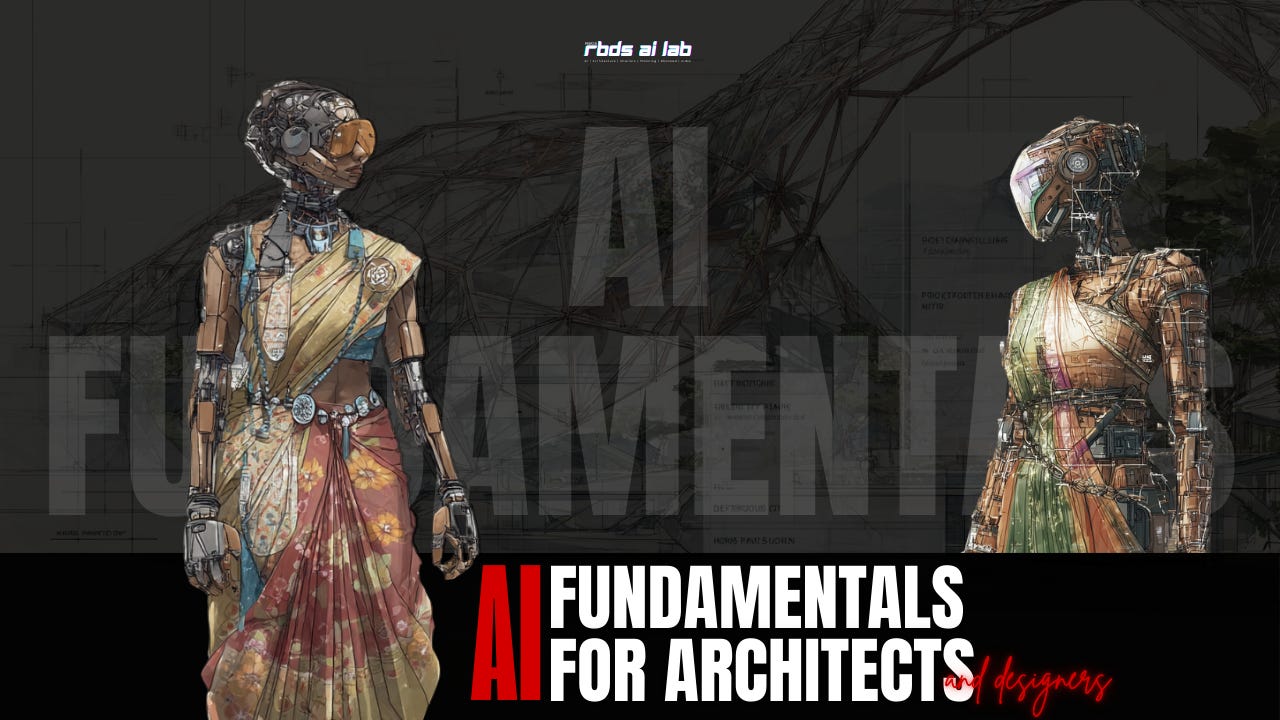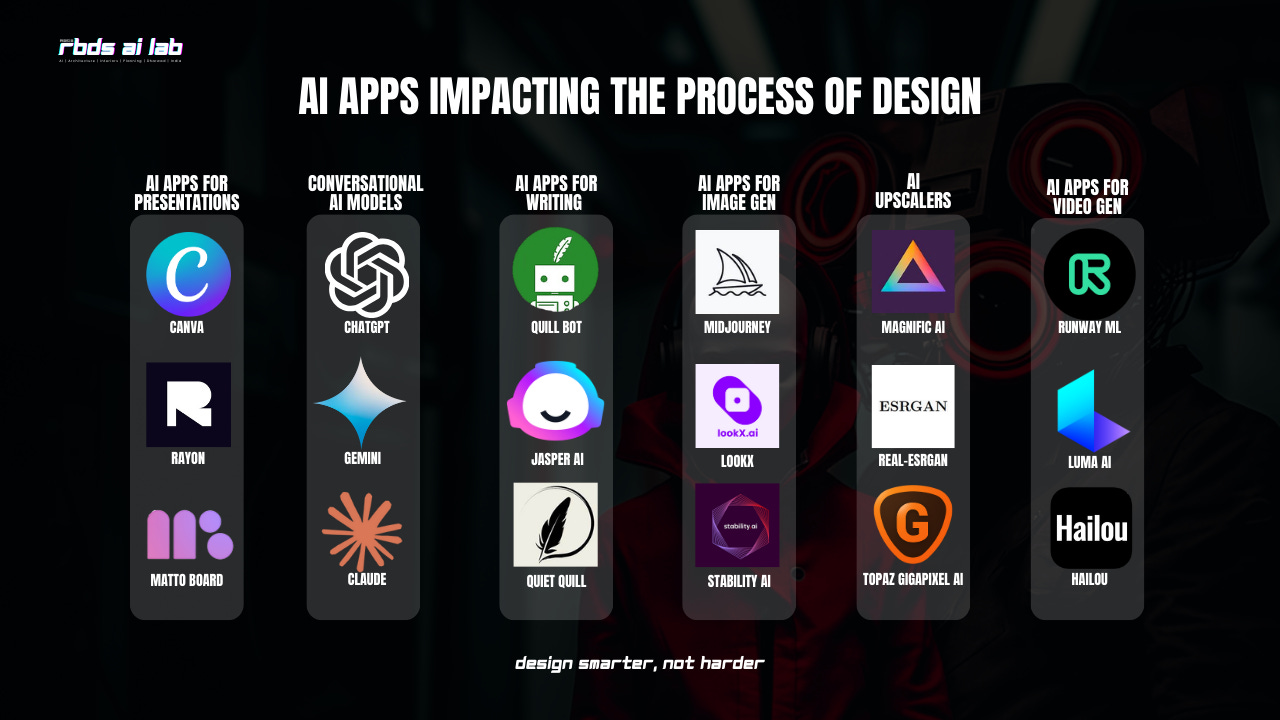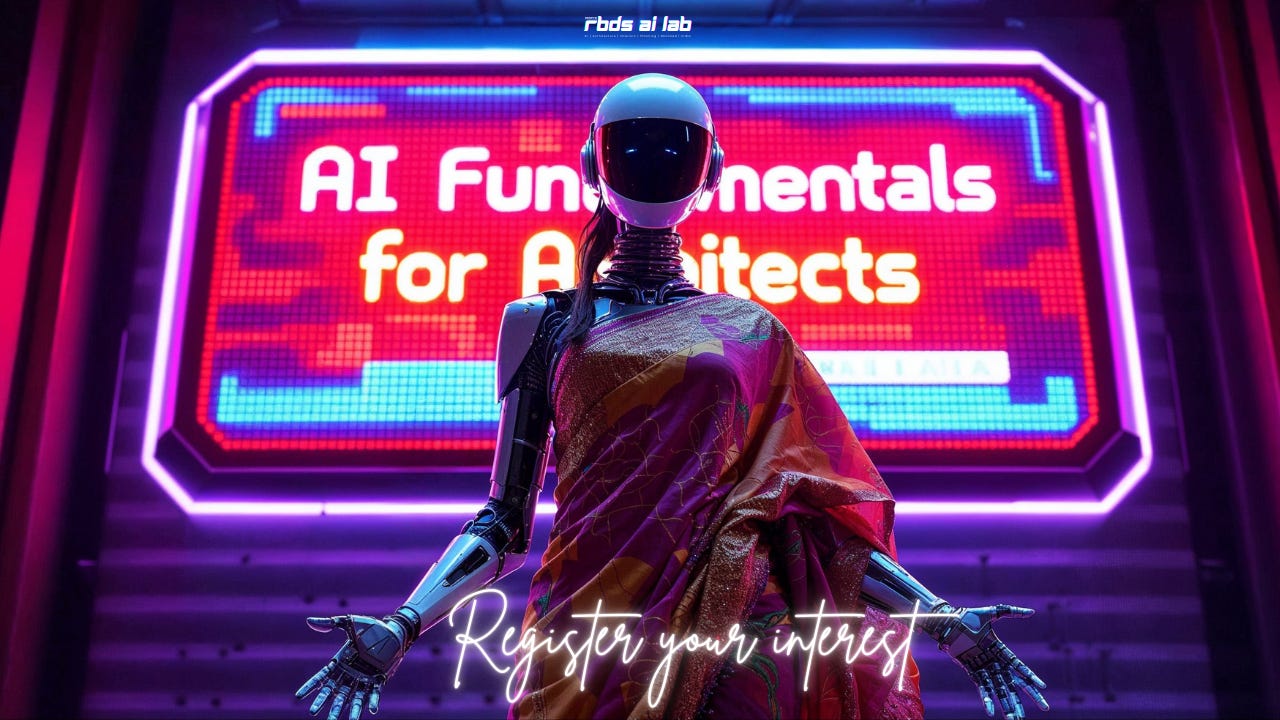AI Fundamentals for Architects: A Starter Manual for the Curious Designer
A field guide to recalibrating design intuition through machines that think, sketch, and whisper back.
Let’s step away from the hype for a moment.
We’ve all seen the reels—the ones where AI conjures gravity-defying skyscrapers and ambiently lit villas in mere seconds. And yes, it’s easy to be seduced by the speed of image generators or the glamour of techno-utopian visions. But here’s the truth that rarely makes it to the screen: the real transformation isn’t in the image. It’s in the thinking.
This isn’t about machines designing for us. It’s about reawakening the designer within us—through intelligent companions that can process, propose, and provoke.
This post offers a glimpse into our full-day AI workshop, where design meets machine, and thinking gets collaborative.
We call it: AI Fundamentals for Architects. A manual. A mindset. A movement.
1. Redrawing Design Thinking with AI
Ask an architect what the hardest part of a project is, and they’ll rarely say rendering. More often, it’s the fog—the early-stage ambiguity of unstructured briefs, unclear clients, and unspoken site conditions.
This is where AI, particularly Large Language Models (LLMs) like ChatGPT, quietly shines. It doesn’t give you answers. It gives you clarity.
2. Prompt Literacy: The New Design Grammar
Most architects default to sketches. But AI demands a new syntax—a structured poetics.
Think of prompting not as a command, but as a brief to your collaborator. Our method breaks it into four pieces:
Role: Who is the AI pretending to be?
Task: What should it do?
Context: Where and why?
Constraints: What must it obey?
The shift was immediate. Prompts became more than text—they became design tools.
3. Visual Brainstorming with Diffusion Models
Before pen meets paper, every design lives in that elusive place—imagination. Diffusion models like Midjourney help materialize that ether without requiring a line drawn.
We call this visual whispering. A subtle way to provoke ideas, not just polish them.
These tools don’t replace concept sketches. They seed them.
Made on Magnific Mystic v 2.5
4. Designing in Motion: AI-Powered Video Generation
Still images are a start—but motion tells a deeper story. Video generation tools like Luma AI and Runway ML help architects simulate experience before execution. Whether it’s a dreamy resort reveal or a quick urban walkthrough, these tools offer time-based storytelling as a design strategy.
These aren't just visuals—they’re experiential tests of how a space might feel in context.
Made on Luma and compiled on Canva
5. Beginner Tech Stack: Curated for Actual Projects
Don’t get lost in a sea of tools. We’ve field-tested these for design relevance:
ChatGPT – for briefing, narratives, design logic
Midjourney – for mood studies
Luma AI – for cinematic walkthroughs
Runway ML – for speculative videos and camera simulations
Magnific – for upscale render polishing
Canva AI – for clean client decks
You don’t need all of them. You need the right ones, at the right time.
Philosophy, Not Just Technology
In our final circle at the workshop, a question came up:
“Isn’t design meant to be human?”
And the answer is: it still is. But ‘human’ is evolving.
AI repositions the architect—not as a controller—but as a conductor. One who orchestrates data, stories, materiality, and now, algorithms.
So if you’ve been waiting for the right moment to explore AI—not just as a renderer, but as a reflector of thought—this is it.
What They Said: Voices From the Studio
Below, you'll find a curated showcase of student work—AI-infused concept boards, cinematic walkthroughs, and design rationales—crafted during one of the full-day workshops.
Honest, insightful, and a reflection of what happens when curiosity meets collaboration.
We’re Housefull in Bangalore
Yes, the Bangalore edition (27th May) is sold out with 50+ architects and emerging designers. But this is just the beginning.
We’re planning new cities. New formats. Smaller groups. More hands-on.
And you can help shape where we go next.
Your Next Steps
👉 Register your interest here so we can plan a workshop near you.
👉 Check out our Gumroad resources for free prompt templates and AI design manuals.
👉 Follow RBDS AI Lab on Instagram for updates, behind-the-scenes, and tool breakdowns.
We’re not building hype. We’re building practice. Join us.
At RBDSai Lab, we are constantly exploring the intersection of AI and design thinking. If this article sparked questions, let’s continue the conversation. Reply with your thoughts or share this with someone who needs to read it.
If you’re an architect or interior designer in India looking to integrate AI into your workflow—not just as a gimmick, but as a philosophy—let’s talk.
Stay curious, stay sceptical, and keep designing. The best ideas are still ahead.
I’m Sahil Tanveer of the RBDSai Lab, signing off for the week. I promote, consult, and apply AI for Architects along with my Architecture and Design Studio, RBDS. If you liked this Substack,
You will love my book, DELIRIOUS ARCHITECTURE: Midjourney for Architects. It is a 330-page hardcover showcasing the potential of AI in Architectural Design. It is available on Amazon worldwide.
You can bend your minds with our WhatsApp channel AI IN ARCHITECTURE where we talk about AI and its impact on us and the built environment.
You can consult with us on AI for your architecture studio. We have multiple levels of learning and integration, from a beginner’s session to the AIMM Assessment and beyond. Get in touch with us at sahil@rbdsailab.com or check out our page www.rbdsailab.com
I’m talking about AI. Our team is set to visit key cities of India for architectural conferences, Podcasts and exclusive student interactions at architecture schools. We’d love to come over for an engaging meetup, hands-on workshop, or a creative collab. Enquiries to sahil@rbdsailab.com









